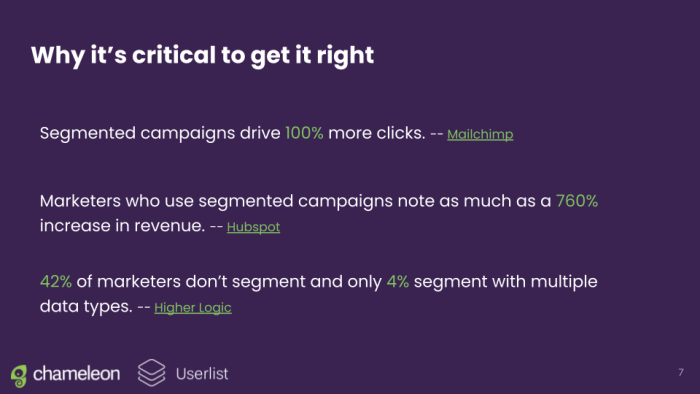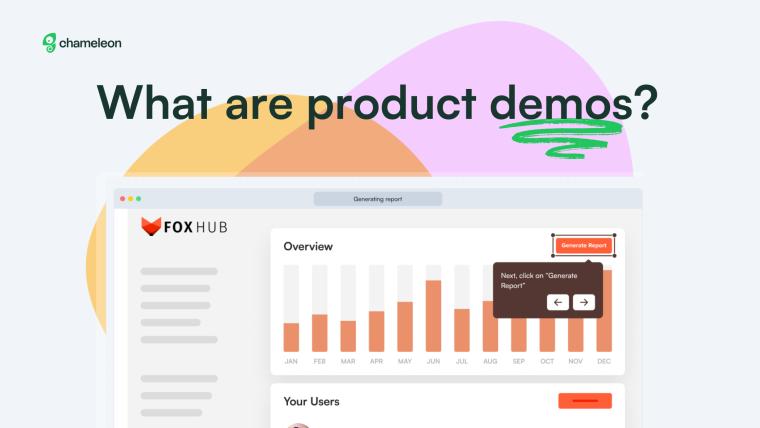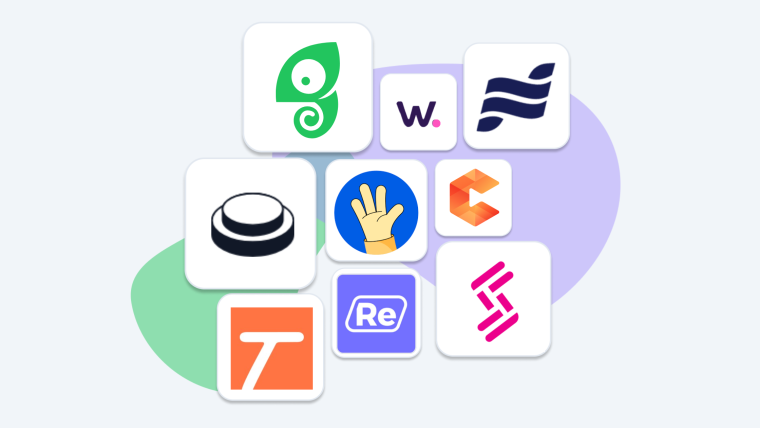Two SaaS company co-founders meet in a webinar, what do they discuss? You can bet that growth, data, and success were hot words in this conversation, or at least they were when Chameleon’s CEO and Co-founder Pulkit Agrawal met with Jane Portman, Co-founder of Userlist, on our recent webinar How to use lifecycle segments to convert and retain your users.
In case you missed it, we’ve got you covered. In this recap, we’ll go over the key points discussed by our product leaders on the benefits of user segmentation, why it's valuable to get it right, and what key segments we should have by each lifecycle stage.
🎥 Want to watch the full webinar? Hit play below!
User segmentation is fundamental to getting your product marketing campaigns just right.
You can avoid targeting users with generic and irrelevant messaging by creating customer segments that group users based on shared traits and behaviors.
Lifecycle segmentation is a helpful framework for SaaS companies operating in free trial and freemium models.
Product usage data like user properties and user events can fuel the implementation and success of user segments.
Perceiving the problem: the need for data-backed segmentation
📷 Picture this: you are running an e-mail automation campaign encouraging free trial users to upgrade to a paid plan. Yet, your number of active users keeps staggering and trials keep expiring with no conversions. What could be going wrong?
Most likely, your message is not reaching the right target audience in order to impact your product’s growth effectively, and that’s when user segmentation becomes fundamental.
Before founding Userlist, Jane Portman realized that in order to get e-mail automation campaigns just right, she needed to develop her own product for it. So, like many SaaS companies, Userlist grew out of a perceived problem.
“I had another SaaS product of my own and there was a clear missing tool in our tool stack, which was a CRM slash email automation platform that could also send behavior-based emails and in-app messages.”
Userlist is an e-mail automation tool for SaaS companies that matches customer data models to create targeted e-mail marketing campaigns. The product allows you to determine user groups and create user segments based on shared traits like user behavior or lifecycle segments.
User segmentation is also one of the key features of Chameleon, a Digital Adoption Platform that lets you target specific user segments with the right in-product experiences at the right time based on product usage and behavior data.
Before we get into the nitty-gritty, let’s cover some basics.
What is user segmentation?
While it is true that every customer has their own pains and needs, it is also true that individual users share some traits with one another. We’re not talking about the attributes envisioned in your user personas or ICPs. While these are based on user characteristics like who they are, and what their goals and pain points are, user segmentation groups customers based on product usage data (data that describe sets of traits or behaviors that relate to their experience with the product).
This is how Userlist defines it:
“A segment is a dynamic group of users who meet a specific rule or set of rules. Segments allow you to filter your users meaningfully with multiple conditions, and identify users who have (or haven’t) taken important actions inside your product.”
As Jane further explains:
“Dynamic is an important part [of user segments], as dynamic means that this is automatically updated based on certain criteria.”
Segmentation is a powerful tool for targeting your user base using criteria that tailors to their experience within your product. User segments allow product marketing teams to target specific user groups with the most relevant messaging, to create personalized user onboarding experiences, and give users what they need at the right time.
“It’s critical to get it right”: the value of user segments
If you ask a stranger down the street to recommend a great place to eat, they might send you somewhere that doesn’t fit your particular tastes. Whereas, if you ask a close friend, they’ll know exactly what you like and give you the best recommendation based on your taste, budget, location, and other important attributes.

User segmentation turns your customers into your best friends. Or most importantly, makes you their best friend. Product-led growth is powered by knowing who your users are, and there is enough data to support the impact that user segmentation has on growth.

Sources: Mailchimp, HubSpot & Higher Logic
As Pulkit Agrawal, CEO and Co-Founder of Chameleon, explains:
“With multiple data types, we're seeing that this is something that's really valuable. Mailchimp and HubSpot, both with broad user bases, big and successful products, saying that segments are so powerful and so much more effective yet so few marketers use it.”
Key segments to follow
There are various traits that can group users within a segment: behaviors, lifecycle stage, sign-up sources, their role within their company (when thinking of B2B products), etc.
An effective framework to implement customer segmentation in SaaS companies is to group users based on lifecycle stages. Here are the best practices for companies operating in free trial and freemium models.
💡How are users navigating through your product adoption curve? Take a look at these five user segments that can help you streamline your growth.
Free trial
In a free trial, users are offered - you guessed it - a free trial for a predetermined period of time to try out a product. The goal is, of course, to activate and convert trial users into paying customers. According to Jane, about 75% of SaaS companies out there operate with a free trial model.

Source: Userlist
As the free trial model journey map shows, each user segment is targeted with a different campaign based on their stage within the lifecycle. Besides the three main categories (trialing users, paying customers, and canceled users), including subcategories like trial expiring and advanced users, can further segment your product marketing strategy.
As Jane Portman puts it:
“The beauty of segments is that each lifecycle segment typically has sort of a conversion goal; an internal goal that you are targeting with all your communications, be it email automation with Userlist or potentially some in-product experiences with Chameleon.”
Freemium
With freemium models, the idea is the same. Your goal is to help users perceive the value of your product, but once they activate, you stop the basic onboarding process to promote upgrades and convert them to paid users.
“The most common use case for it all is user onboarding. That's why it's a hot word, but for our own customers, we deeply encourage them to look for opportunities in the middle of the lifecycle, because those loyal customers, they're your advocates. You can do so many things with them and basically put a lot of your proactive customer success on autopilot.”
What comes first? The data or the segmentation?
This is one of those philosophical chicken-or-the-egg questions.
Jane says that you will not get an e-mail automation campaign right unless you have data segments and actual campaigns, but where do you start?
“Segments are like the chicken and the egg starting point between the data and the campaigns. If you get the segments, you will know what data you need to define them. And you will also know what campaigns you'll be sending. So it's the central part of planning for everybody who's starting out.”
Should you track accounts or individual users?
Jane’s advice is to apply most segments on the company (account) level, but you must still consider that each user in an account will have their own timeline. 🤯
“The solution to this puzzle is that in addition to having one big account onboarding, you should also have mini individual user onboarding campaigns, and those should also be tailored.”

In other words, segment your customer segments for further segmentation 😂As you look at individual users within an account, ask the following questions:
Are they first-time or second-time users?
Have they joined during the trial or later?
Were they the admin who created an account?
What is their role within the company?
These questions can guide your tailored onboarding campaigns that will lead individual users to the account-level campaigns that follow the lifecycle.
But what data should you look out for?
Product-led growth is powered by knowledge (a.k.a data). Besides insights from lifecycle marketing data that tell you product growth stats like churn rate, number of active users, and customer lifetime value, it’s also crucial to track product usage data that pertains to individual user experiences and actions within the product. This is the key to segmentation.

User Properties vs. User Events
User properties are attributes of individual users that contextualize their experience within your products and the events they trigger. Some common user properties are: device type, location, user ID, language, etc.
Event properties, as the name suggests, are attributes of a particular event (read: action) that users trigger within your product. For example, if sign up is an event you’re tracking, the event property plan type could have the values corresponding to the plans you offer.
Segmentation tools
Now that we’ve covered what user segmentation is, why it matters, and what kind of data you need to be tracking, we’re ready to equip you with the best tools to start tracking and targeting your user segments.
Tracking
Iteratively: data sourcing and event tracking
An Amplitude company, Iteratively lets you streamline event tracking plans, bringing collaboration, revision history, and relevant data to your analytics architecture.
Customer Data Platforms (CDPs)
Segment: a hub for APIs
Segment collects customer data and sends it to hundreds of tools, making it easier to create your segments based on various data points like performance analytics or CRM updates.
Freshpaint: no-code event tracking
Freshpaint connects clicks on your website to your marketing and analytics tools, without engineering support. It sends user data (properties and events) to your product to target specific users with highly personalized experiences.
Cohort syncing
Mixpanel: product analytics
Mixpanel helps you better understand user journeys and answer questions about user behavior and engagement to more deeply analyze and target in-product experiences.
Heap: automatic analytics tracking
With Heap you can capture and tag events without tracking code and retrospectively analyze data for faster decisions.
Messaging Channels
Userlist: targeted e-mail automation
With Userlist you will put an end to spamming your customers with irrelevant e-mail. It allows you to track company-level data, and trigger campaigns based on company-level events.
Chameleon: tailored in-product experiences
Chameleon lets you target your user segments with in-app experiences like product tours, user feedback surveys, tooltips, checklists, and more. Chameleon helps you boost product adoption by sending users relevant messaging at the right time.
Conclusion
Now it's like you were in the webinar with us! Are you eager to start working on your user segmentation right away?
Remember:
Your user segments need to make sense with your product: do not opt for cohorts that are not interesting for you to engage with.
Each campaign will have its ideal user segments to target: use your data to guide the way!
Product usage data like user properties and events will become your best allies; get some tracking tools into your stack to start collecting it!





